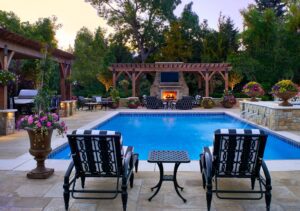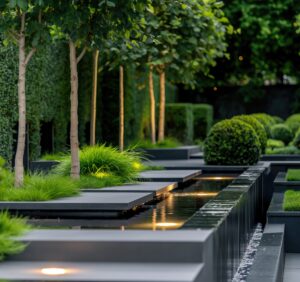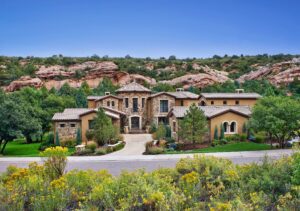The gentle sound of flowing water creates an immediate sense of tranquility in any outdoor space. Water features serve as captivating focal points that transform ordinary landscapes into extraordinary retreats, engaging multiple senses while providing numerous practical benefits. At Browne Associates, we specialize in designing and installing custom water elements that perfectly complement your property’s unique characteristics.
From subtle bubbling rocks to dramatic waterfalls, our expertly crafted water features enhance your outdoor living experience while adding significant value to your property. Whether you seek a meditative garden sanctuary, a stunning visual centerpiece, or a natural habitat for local wildlife, incorporating water into your landscape design achieves these goals while creating a distinctive atmosphere impossible to replicate with other elements.
Our professional team guides you through the entire process, from initial concept to final installation, ensuring your water feature becomes a seamless and enchanting addition to your outdoor environment.
The Transformative Benefits of Water Features
Creating Tranquility and Stress Reduction
The therapeutic effects of water features extend far beyond mere aesthetics. Recent studies from late 2024 confirm that the gentle sounds of flowing water trigger measurable physiological responses in the human body, including reduced blood pressure, lowered heart rate, and decreased cortisol levels.
These natural stress-reduction mechanisms explain why time spent near water features consistently produces feelings of calm and relaxation.
Water features effectively mask disruptive environmental noise, creating peaceful sanctuaries even in busy neighborhoods. The consistent sound of trickling or flowing water naturally blocks traffic noise, neighbor conversations, and other urban disturbances. This acoustic masking effect transforms your garden into a private retreat where you can escape the constant stimulation of modern life.
The sensory engagement provided by water features creates a natural mindfulness experience. The combination of visual movement, gentle sounds, and the subtle feeling of increased humidity engages multiple senses simultaneously, anchoring your attention to the present moment.
This multi-sensory experience explains why water features have been central elements in meditation gardens across cultures for centuries, providing natural focal points that quiet the mind and restore mental clarity.
Enhancing Aesthetic Appeal and Property Value
A thoughtfully designed water feature serves as a captivating focal point that elevates your entire landscape design. Water introduces dynamic movement into otherwise static garden scenes, creating visual interest that changes constantly with light conditions, wind patterns, and seasonal variations. This ever-changing quality ensures your landscape remains visually engaging throughout the year.
Water features provide exceptional design versatility, complementing any architectural style or landscape theme. From formal fountains that enhance traditional properties to naturalistic streams perfect for woodland gardens, water elements adapt to your specific aesthetic preferences.
The reflective properties of water also effectively double the visual impact of surrounding plantings and structures, creating a sense of expanded space and enhanced beauty.
From a practical investment perspective, professionally installed water features significantly increase property values. Real estate professionals consistently rank water elements among the top landscape improvements for return on investment, with many buyers willing to pay premium prices for homes with established water features.
This value enhancement stems from both the immediate visual appeal and the perception of luxury and tranquility these features convey to potential buyers.
Supporting Wildlife and Biodiversity
Water features naturally attract and support local wildlife, creating miniature ecosystems within your landscape. Birds, butterflies, dragonflies, and beneficial insects all depend on reliable water sources, especially during hot summer months. By incorporating a water feature, you provide essential habitat that supports biodiversity while creating opportunities for wildlife observation and connection with nature.
Even modest water elements significantly increase the variety of plant species you can incorporate into your landscape design. Moisture-loving specimens that might otherwise struggle in typical garden conditions thrive near water features, allowing for expanded planting palettes and greater botanical diversity. This plant variety further enhances wildlife support by providing additional food sources and habitat niches.
Water features contribute to improved environmental conditions beyond their immediate surroundings. The evaporation process naturally humidifies and cools the surrounding air, creating microclimates that benefit both plants and people. This cooling effect proves particularly valuable during hot summer months, potentially reducing air conditioning needs for adjacent structures while creating more comfortable outdoor living spaces.
Types of Water Features for Your Landscape
Fountains and Bubblers
Fountains remain among the most versatile and popular water features, suitable for properties of virtually any size. From dramatic multi-tiered designs that serve as garden centerpieces to subtle wall fountains perfect for intimate spaces, these features combine visual impact with the soothing sounds of moving water.
Modern fountain designs range from classically inspired to strikingly contemporary, ensuring options that complement any architectural style.
Bubbling rocks and small recirculating fountains provide perfect solutions for limited spaces or modest budgets. These compact features create the sensory benefits of larger water elements while requiring minimal installation complexity. Many designs operate with surprisingly small water volumes, recirculating the same water continuously for efficiency and sustainability.
Their modest footprint allows integration into existing landscapes without major reconstruction.
Self-contained fountains offer exceptional flexibility, allowing for repositioning as landscape needs change or seasonal adjustments become necessary. Many contemporary designs incorporate LED lighting elements that extend enjoyment into evening hours, creating dramatic nighttime focal points.
The wide range of available styles, from natural stone to sleek architectural forms, ensures options that perfectly complement your specific landscape aesthetic.
Ponds and Reflection Pools
Natural ponds create immersive water experiences that serve as dynamic focal points while supporting diverse aquatic ecosystems. These features can range from intimate garden pools to substantial landscape elements capable of supporting fish, aquatic plants, and wildlife. The reflective surface of still water dramatically enhances landscape beauty by mirroring surrounding plantings, architecture, and sky conditions.
Reflection pools emphasize water’s mirror-like qualities, creating dramatic visual effects through carefully controlled design. These architectural water features typically feature simple geometric forms with dark bottom surfaces that maximize reflectivity. The minimal water movement maintains pristine reflective surfaces while still providing subtle sound elements through small water spouts or gentle overflow edges.
Ecosystem ponds represent the most naturalistic approach, creating self-sustaining aquatic environments that require minimal maintenance once established. These balanced systems use biological filtration, beneficial bacteria, and appropriate plant selection to maintain water clarity without chemical treatments.
The resulting mini-ecosystems support remarkable biodiversity while providing ever-changing visual interest throughout the seasons.
Streams and Waterfalls
Flowing water features like streams and waterfalls create dynamic landscape elements that guide movement and engage multiple senses. The sound of water cascading over rocks produces the most pronounced acoustic effects of any water feature type, effectively masking environmental noise while creating a sense of immersion in nature. These features work particularly well on sloped properties where they can follow natural topography.
Pondless waterfalls offer the dramatic visual and acoustic benefits of traditional waterfalls without the maintenance requirements of open water bodies. These systems circulate water from hidden underground reservoirs through naturalistic rock formations, then collect it again without creating exposed standing water. This design approach proves ideal for properties with small children or where minimal maintenance is desired.
Stream courses create connective elements that link different landscape areas while providing extended water experiences. These meandering features can incorporate multiple small cascades, quiet pools, and crossing points that encourage interaction and exploration.
When designed with appropriate stone selection and placement, these features appear as though they’ve always been part of the landscape, creating an authentic sense of natural beauty.
Design Considerations for Water Features
Site Selection and Environmental Factors
Successful water features begin with thoughtful site evaluation that considers both aesthetic and practical factors. Visibility from key viewpoints, including indoor living spaces and outdoor seating areas, ensures maximum enjoyment of your investment. Consider seasonal sun patterns, as excessive direct sunlight can promote algae growth and increase water evaporation, while complete shade might limit plant options for naturalistic features.
Proximity to existing utilities requires careful consideration during the planning phase. Water and electrical connections facilitate installation and operation, while avoiding underground utilities prevents costly complications during construction. Proper distance from structures protects foundations from potential moisture issues, with specific setbacks determined by feature type and local building codes.
Existing topography significantly influences water feature design and installation costs. Working with natural slopes often creates more authentic-looking features while reducing excavation requirements. For flat sites, creating elevation changes through strategic soil placement can achieve similar effects while generating visual interest throughout the landscape.
Professional designers evaluate these site-specific factors to develop water features that appear natural and integrated rather than artificially imposed.
Material Selection and Aesthetic Integration
The materials chosen for your water feature dramatically influence both its appearance and longevity. Stone selection represents one of the most important decisions, as these elements remain visible and define the feature’s character. Local stone varieties typically create the most authentic appearance while often reducing transportation costs and environmental impact.
Careful matching of stone types with your property’s existing hardscape elements ensures visual cohesion throughout the landscape.
Liner materials determine water feature durability and maintenance requirements. Modern synthetic liners offer exceptional longevity when properly installed and protected, with warranties often exceeding 20 years. For more formal features, architectural concrete, copper, or stainless steel provide distinctive aesthetic options with excellent durability.
Material selection should balance initial cost against long-term performance expectations and maintenance considerations.
Surrounding plantings play crucial roles in integrating water features into the broader landscape. Transitional plantings that bridge between water edges and existing landscape areas create natural-looking connections. Plant selection should consider moisture tolerance, mature size, and seasonal interest to enhance the water feature throughout the year.
Professional designers develop comprehensive planting plans that complement water elements while thriving in the specific microclimate conditions these features create.
Technical Requirements and Maintenance Considerations
Proper circulation systems form the foundation of successful water features, ensuring water quality and desired aesthetic effects. Pump selection balances energy efficiency with appropriate flow rates for specific feature types. Modern variable-speed pumps offer exceptional efficiency by adjusting output to changing conditions.
Professional installation includes proper pump sizing and placement to ensure optimal performance while minimizing operational costs.
Filtration requirements vary significantly between different water feature types. Natural ponds typically incorporate biological filtration through beneficial bacteria and aquatic plants, while architectural features might utilize mechanical filtration systems to maintain water clarity. Proper filtration design prevents common issues like cloudy water or excessive algae growth that can diminish enjoyment of your water feature.
Seasonal maintenance needs should influence design decisions, particularly in regions with freezing winter temperatures. Features designed for year-round operation require specific components and installation techniques to prevent damage during freeze-thaw cycles.
Alternatively, systems designed for seasonal operation include provisions for simple winterization. Professional designers address these technical considerations during the planning phase, creating water features that provide maximum enjoyment with appropriate maintenance requirements for your lifestyle.
Working with Browne Associates for Your Water Feature
Our Collaborative Design Process
At Browne Associates, we believe successful water features begin with a thorough understanding of your vision, preferences, and how you intend to enjoy your outdoor space. Our collaborative design process starts with comprehensive consultation where we discuss your aesthetic preferences, desired water feature benefits, budget parameters, and maintenance expectations.
This foundation ensures the resulting design aligns perfectly with your specific needs rather than following generic templates.
Following initial consultation, our design team conducts detailed site analysis to identify opportunities and constraints specific to your property. This evaluation includes topographical assessment, soil testing, existing vegetation inventory, and identification of viewsheds that might be enhanced by water features.
We consider seasonal light patterns, existing drainage characteristics, and proximity to outdoor living spaces to determine optimal feature placement and configuration.
The design development phase translates your vision and site conditions into detailed plans that guide implementation. We present concept drawings that illustrate how your water feature will appear from multiple viewpoints, including perspectives from key indoor and outdoor living spaces.
These visualizations help you understand exactly how the proposed feature will transform your landscape before any construction begins. Throughout this process, we welcome your feedback and make refinements to ensure the final design exceeds your expectations.
Professional Installation and Ongoing Support
Our expert installation team brings decades of combined experience to your project, ensuring flawless execution of even the most complex water feature designs. We handle all technical aspects including excavation, structural work, liner installation, plumbing, electrical connections, and finish details.
Our comprehensive approach means you work with a single company throughout the entire process, eliminating the coordination challenges often associated with multiple contractors.
During installation, we maintain clear communication about project progress and any adjustments needed to address unforeseen site conditions. Our team takes exceptional care to protect existing landscape elements and minimize disruption to your property. We manage all aspects of the installation process, including permitting when required, ensuring compliance with local regulations and building codes.
Upon completion, we provide detailed guidance on water feature operation and maintenance requirements. This includes hands-on demonstration of all system components, seasonal care instructions, and troubleshooting information. For clients desiring ongoing support, we offer maintenance programs tailored to your specific water feature type and personal preferences.
These services range from seasonal cleanings and system checks to comprehensive care packages that ensure your water feature remains a trouble-free source of enjoyment for years to come.
FAQ: Water Features for Your Landscape
1. How much maintenance do water features require?
Maintenance requirements vary by feature type and design. Pondless waterfalls and bubbling rocks typically need minimal attention—quarterly cleaning and occasional pump checks. Traditional ponds require more regular care, including debris removal, seasonal cleanings, and water quality monitoring.
Self-contained fountains generally need weekly water level checks and periodic cleaning. All water features benefit from professional seasonal service to ensure optimal performance. Modern designs incorporate maintenance-reducing elements like skimmers, automatic fill valves, and UV clarifiers that significantly decrease required upkeep while maintaining water quality and aesthetic appeal.
2. What are the most energy-efficient water feature options?
Today’s energy-efficient water features utilize variable-speed pumps that adjust power consumption based on flow requirements, potentially reducing energy usage by 70% compared to older systems. Solar-powered options work well for small features in sunny locations. Pondless designs typically consume less energy than traditional ponds of similar size.
Proper system design—including appropriate pipe sizing, minimal elevation changes, and strategic pump placement—significantly impacts efficiency. LED lighting uses 80% less electricity than halogen alternatives while providing dramatic nighttime effects. Professional design addresses these efficiency factors, creating beautiful water features with minimal operational costs.
3. Can water features be installed in small spaces or urban gardens?
Absolutely! Small spaces benefit tremendously from appropriately scaled water features. Wall fountains require minimal footprint while providing visual interest and soothing sounds. Compact bubbling urns or ceramic vessels create focal points in tiny gardens or on patios. Container water gardens combining miniature aquatic plants with small recirculating features work perfectly in limited spaces.
Vertical water walls maximize impact in narrow areas. Even balconies can accommodate tabletop fountains that provide therapeutic benefits in urban environments. Professional designers specialize in creating space-appropriate water features that enhance small gardens without overwhelming them.
4. How do water features affect local wildlife?
Water features significantly benefit local wildlife, particularly in urban and suburban environments where natural water sources may be limited. Birds regularly visit for drinking and bathing, while beneficial insects like dragonflies often establish populations around water. Even small features attract pollinators, especially during dry periods.
Features with varying water depths support different wildlife needs—shallow edges for butterflies and bees, deeper sections for aquatic organisms. Including native aquatic plants further enhances habitat value. For those concerned about mosquitoes, properly designed features with moving water or appropriate biological controls effectively prevent breeding while supporting beneficial wildlife.
5. What’s the typical investment range for professional water features?
Investment ranges vary widely based on size, complexity, and materials. Small self-contained fountains typically range from $1,500-$5,000 installed. Pondless waterfalls generally start around $5,000-$8,000 for basic installations, while more elaborate designs with extensive rockwork might reach $15,000-$25,000.
Traditional ponds with filtration systems and aquatic plantings typically range from $8,000-$30,000 depending on size and features. Custom architectural water features can range from $10,000 to $50,000+. Professional installation ensures proper construction techniques that prevent costly problems while maximizing long-term enjoyment and property value enhancement.
6. How do water features perform in Colorado’s climate?
Colorado’s climate presents unique considerations for water features. Our designs account for intense UV exposure, low humidity, and significant temperature fluctuations. Deeper basins prevent excessive evaporation during hot, dry periods.
Proper equipment selection ensures functionality during freezing temperatures—either through winterization provisions or components rated for year-round operation. Wind-resistant designs prevent excessive water loss through spray drift.
Strategic placement maximizes enjoyment while minimizing environmental stressors. Native and adapted aquatic plants selected specifically for our climate thrive with minimal care. Our extensive experience with Colorado’s specific conditions ensures water features that perform beautifully despite challenging climate factors.



